Windows Live Search Books, Microsoft’s answer to Google Book Search, is officially up and running and looks and feels pretty much the same as its nemesis. Being a Microsoft product, the interface is clunkier, and they have a bit of catching up to do in terms of navigation and search options. The one substantive difference is that Live Search is mostly limited to out-of-copyright books — i.e. pre-19231927 editions of public domain works. So the little they do have in there is fully accessible, with PDFs available for download. Like Google’s public domain books, however, the scans are of pretty poor quality, and not searchable. Readers point out that Microsoft, unlike Google, does in fact include a layer of low-quality but entirely searchable OCR text in its public domain downloads.
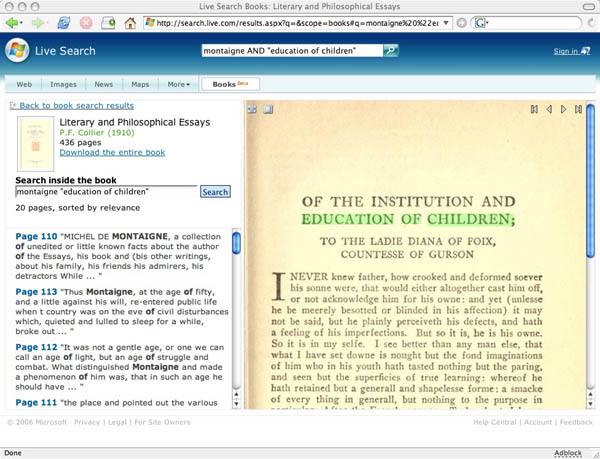
Monthly Archives: December 2006
ITIN place | 2007 redux: design journal, part 3
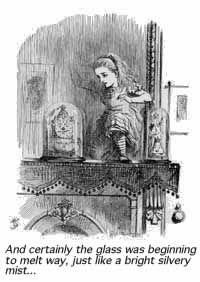 (read parts 1&2)
(read parts 1&2)
[3] I’d just begun hard coding navigational elements for the new ITIN archives, when I suspected Through the Looking-Glass might be an apt, fun read to offset the growing angst around coding. Maybe something in literature would provide the gestalt I felt missing from the minutia of writing lines of functions, booleans, and parameters. Sounds holistic maybe, but this suspicion plus a Wikipedia entry I’d read on Lewis Carol convinced me it’d be the perfect read just now. So, when I was walking through Penn Staten earlier last month, I found a bookseller in the LIRR station and, all excited, I picked up a copy of Alice’s Adventures, with the intentions of breezing through it in order to move onto Looking-Glass. It was nice to open ITIN place the next day to find Stormy Blues For Alice In The Looking Glass. Somehow, the two had already met.
Sally: I’ve been trying to figure out some of the back-end stuff for the past few days, namely, how to get your entire archive to link up to something like this. Do you have any programming / web design wizard friends who might be able to offer me some technical advice?
Alex: God know…. I guess we’ll have to build them manually…some 700 links? yipes.
Alex: I mean, god no….LOL
Sally: Hey, I’m working with a programmer now on a script that will allow the archive to thumbnail images from your entries and automatically load them (& URLs to the corresponding entries) into the Flash file. I don’t know PHP, which is likely the language needed to thumbnail your images automatically, so I’m getting help on that. Once that’s in place, we should be able to (a) play further with layout aspects! and (b) the archive should automatically update every time you publish an entry. Getting closer…
Alex: and it will still do that animated scale up and down trick?
Sally: my PHP programmer who would work on the thumbnail-ing flaked out on me, seems programmers can be as flaky as drummers… So, I set it upon myself to teach myself Flash-based blog applications. At its simplest, it requires a little PHP, a little XML and Flash, all in conversation with what you post online.

Ben: As for PHP gurus… We do in fact have someone working with us right now who’s an experience PHP coder. We’re keeping him pretty busy right now with MediaCommons stuff, but I think he could help you out with this stuff in a few weeks.
Sally: I also imagine there should be more than one way to search / browse the archives. One might be a linear “wall” from month to month that we could click/scroll through, another might be a drop-down menu of months say, to the right of the “wall” of images. Any thoughts on that?
Meanwhile, I’d plotted out on my whiteboard a map of the flash file. It looked to me that there were two methods of approach, interface-wise. Either the zoom function would scale up the size of an entire month’s calendar, and a re-center or panning function would allow the user to focus on a particular entry – or – the zoom function would simply scale up one entry at a time onrollOver (the original idea).
I am (still) drawn to the first idea, even though I’ve put it aside, since that would best recreate the sense of approaching a gallery wall, or landing on the (x,y) of Alex’s blog. But, caveats abound — if an onPress fires the zoom and re-center, then how do you click the entry’s permalink and/or zoom out? Is this overcomplicating things? Here is an example of an unweildy new zoom (an attempt to manage dragging and zooming).
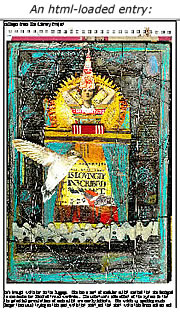 Then I started to think about loading in individual blog entries from the XML. I talked to my friend Mike about this for a while and in exchange for some brownies (although really only out of his extreme kindness and generosity) he constructed an XML format, sample.xml, and guided me on a way to load in the HTML of each individual entry into a small clip.
Then I started to think about loading in individual blog entries from the XML. I talked to my friend Mike about this for a while and in exchange for some brownies (although really only out of his extreme kindness and generosity) he constructed an XML format, sample.xml, and guided me on a way to load in the HTML of each individual entry into a small clip.
The great thing about using the HTML of each entry in the previous example is that it would allow the archives to build completely dynamically. Any changes Alex made in an archived post would reflect in real time in the flash file. Unfortunately, this doesn’t cut down on load time and I can’t coax the videos and animated .gifs to appear (of which there are considerable number). Here is an example of one entry pulled into the Flash file with HTML. CSS can be incorporated, but it’s obviously slow loading.
Mike brought up something I’d wondered too too: are we going to have one XML file for the entire archive? It seems to make more sense for each month to have it’s own.
So, after a few weeks, I caught up with Future of the Book’s expert developer Eddie Tejeda, and we decided to put an XML document within each month. On an exciting note, Eddie devised a great scheme (script) to take screen shots of all of ITIN place’s entries. He’s working on getting the image size down, so as to minimize loading time.
Eddie’s screen shots would load much faster than pure HTML, but it could possibly cut the dynamism. This would build something like this, only faster:
Most of the hard coding of the archive is done. Design matters remain: At the moment, the entries load in rather like a retro computer solitaire game, and drop down menus are disconnected and unskinned. It’s a task to go back and forth between design and developing — I’m just cutting my teeth on some of this and the dryness of programming can dilute creative inspiration (if this is anything to go by). The archive is very close to complete; it will be a thrill to use this gentler beast.
how would you design the iraq study group report for the web?
The “Iraq Study Group Report” paperback could have been wrapped in a brown paper bag, its title scrawled in Magic Marker. It would still sell. This is a book, unlike trillions of others on the market, whose substance and national import sell it, not its cover…Disproving the adage, this genre of book can indeed be judged by its cover. From the reports on the Warren Commission to Watergate, Iran-contra and now the Iraq war, such books are anomalies for a publishing industry that churns out covers intended to seduce readers, to reach out and grab them, and propel them to the cash register.
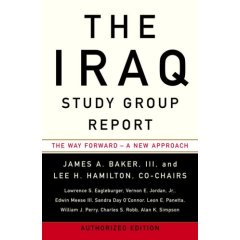

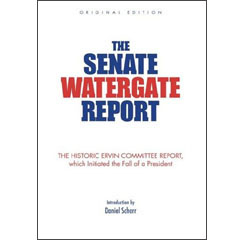
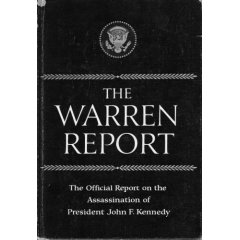
How would you design an unauthorized web edition of the ISG Report? Would you keep to the sober, no-nonsense aesthetic of the iconic print editions of past government documents like the 9/11 Commission Report or the Warren Commission Report? Or would you shake things up? A far more interesting question: what functionality would you add? What kind of discussion capabilities would you build into it? Who would you most like to see annotate or publicly comment on the document?
The electronic edition that has been making the rounds is an austere PDF made available by the United States Institute of Peace. A far more useful resource for close reading of the text was put out by Vivismo as a demonstration of its new Velocity Search Engine. They crawled the PDF and broke it into individual paragraphs, adding powerful clustered search tools.
The US Government Printing Office has a slew of public documents available on its website, mostly as PDFs or bare-bones HTML pages. How should texts of “national import” be reconceived for the network?
thoughts? suggestions?
 We’re in the midst of making improvements to the commenting interface that we developed for Mitch Stephens’ Holy of Holies paper, readying it for another project (more about that soon) and, eventually, for general release as a Word Press theme. Trusting the old saw that with a million eyes, all bugs are shallow, we wanted to ask for your help — and on one area in particular.
We’re in the midst of making improvements to the commenting interface that we developed for Mitch Stephens’ Holy of Holies paper, readying it for another project (more about that soon) and, eventually, for general release as a Word Press theme. Trusting the old saw that with a million eyes, all bugs are shallow, we wanted to ask for your help — and on one area in particular.
You’ll notice that on any section of the paper, the default state for the discussion area in the righthand margin is a list of all the comments for that section. Our intention with this was to give readers a sense of the overall flow of the discussion, permitting them to tunnel into individual paragraphs by way of the comments rather than just the other way around. Our concern, however, is that in its current rough state it might be more confusing than helpful. We’d be grateful if you could take a moment to look at this feature again, click around, and let us know what we could do to make it better (and feel free to mention anything else you think needs work).
do editors dream of electrifying networks?
Lindsay Waters, executive editor for the humanities at Harvard University Press, mentions the Gamer Theory “experiment” in an interview at The Book Depository:
BD: What are the principal challenges/opportunities you see at the moment in the business of publishing books?
LW: The principal challenge is that the book market is changing drastically. The whole plate techtonics is in motion. One chief challenge is not to get unnerved, not to believe Chicken Little as he runs up and down Main Street screaming “the sky is falling.” Books are not going to disappear. We have to experiment with the book which is what we are doing when, for example, we publish McKenzie Wark’s Hacker Manifesto and his forthcoming Gamer Theory.
Gamer Theory is a book that is already available on the web in electronic form, but we believe there is enough of a market for the print version of the book to justify our publishing the book in hardcover. This is an experiment.
One hopes the experimentation doesn’t end here. Last week, we had some very interesting discussions here on the evolution of authorship, which, while never going explicitly into the realm of editing, are nonetheless highly relevant in that regard. In one particularly excellent a comment, Sol Gaitan laid out the challenge for a new generation of writers, which I think could go just as well for a nascent class of digital editors:
…the immediacy that the Internet provides facilitates collaboration in a way no meeting of minds in a cafe or railroad apartment ever had. This facilitates a communality that approaches that of the oral tradition, now we have a system that allows for true universality. To make this work requires action, organization, clarity of purpose, and yes, a new rhetoric. New ways of collaboration entail a novel approach.
Someone is almost certainly going to be needed to moderate the discussions that come out of these complex processes, especially considering that the discussions themselves may consitute the bulk of the work. This task will in part be taken up by the author, and by the communities themselves (that’s largely how things have developed so far) but when you begin to imagine numerous clusters of projects overlapping and cross-pollinating, it seems obvious that a special kind of talent will be required to see the big picture. Call it curating the collective — redacting the remix. Organizing networks will become its own kind of art.
Later on in the interview, Waters says: “I am most proud of the way so many of my books constellate. I see these links in my books in literature, philosophy, and also in economics…” Editors have always been in the business of networks — the business of interlinking. More are now waking up to the idea that web and print can work productively, and even profitably, together. But this is at best a transitional stage. Unless editors reckon with the fact that the internet presents not just a new way of distributing texts but a new way of making them, plate techtonics will continue to destabilize the publishing industry until it breaks apart and slides into the sea.
they live like aristocrats. now they think like them
is the title of a scathing critique by Marina Hyde in this morning’s Guardian, in which she takes Bono and other wealthy musicians to taks for trying to extend the copyright on recorded music in the U.K. from the current 50 years to 95. Worth a read, particularly to get a sense of how the issue of “class” which is almost never raised in mainstream U.S. publications is a crucial part of the discussion of issues like this in Europe.
talk about an active “reader”
Alex Itin commenting on this video:
“. . . it’s great that video games involve the body. It is in this way that new media will pass literature. I quit writing for painting, because I couldn’t stand the loss of the physical that went into writing novels…. but in painting it is hard keep the intellectual (so much good about painting is metaphysical and physical and theory and ideas seem to get in the way of the act)…The reason I keep beating my head against the new media wall is that I sense it will allow me to have my cake and eat it too.”
small steps toward an n-dimensional reading/writing space
A few weeks ago, Mitch Stephens came to us with an interesting challenge: to design a social reading environment for a paper he will be presenting this Friday, Dec. 8 at a conference on religion and media at New York University. The paper, “Holy of Holies: On the Constituents of Emptiness”, is now live. This paper draws on the research Mitch has been doing for his book-length study of the history of atheism. It concerns the 1st century B.C.E. episode of the Roman general Pompey’s incursion into the tabernacle of the Second Temple. What he finds there… well, you’ll see. It’s a fascinating piece, which makes some interesting connections between belief systems and media systems, and it’s ready for your comments, annotations and criticims which you can post paragraph by paragraph through the text. It’s a new format that we’re playing with that could give new meaning to the idea of the “working paper.” We’re still fixing bugs and adding new features, but the basic apparatus is there. Take a look.
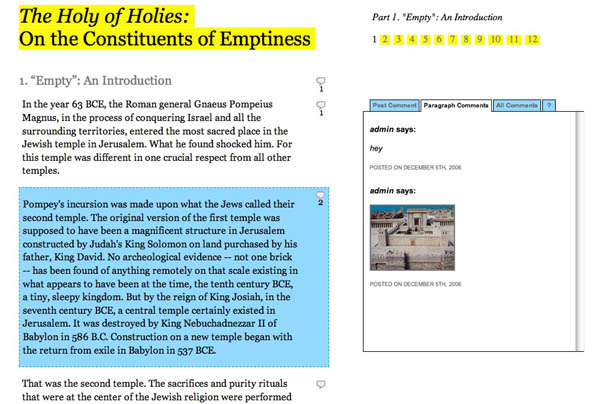
Over the past few months, Mitch has been moving out of the research stage and into full-on writing of his manuscript, and as a result he’s been thinking about workshopping larger chunks of text on his blog. This presents something of a quandary, however, as the short, pithy format of the blog, so good at sparking discussions generally, is not very good at dealing with longer expository texts. Earlier in November Mitch posted a draft of his book’s prologue with the hopes of getting substantive feedback from readers. The response was interesting but meager, largely owing to the fact that the discussion (on the blog) was so totally divorced from the actual text (a Word doc download). He had opted not to publish the prologue directly onto the site, since that would have meant breaking it up into multiple posts to create more points for commenting. This struck him as too clunky, especially considering the reverse-chronological order of the blog would necessitate posting the paper back to front. So he went with the download option. With his new paper he hoped to do something better, so he came to the Institute, or the “garage” as he calls it, to see if we could engineer a new approach.
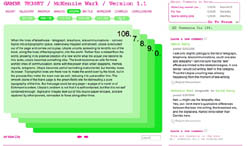 We had of course already done this with Gamer Theory. Our goal there had been to create a more richly interactive reading environment than was typically found in things broadly designated as “e-books,” an environment that offered multiple entry points for discussion and which placed reader input on roughly equal footing with the author’s text. This led to the deck of cards structure with comment areas to the side. Networked marginalia you might say, but far from marginal in its impact. As we had hoped/suspected, the discussion became a vital part of the book as a whole.
We had of course already done this with Gamer Theory. Our goal there had been to create a more richly interactive reading environment than was typically found in things broadly designated as “e-books,” an environment that offered multiple entry points for discussion and which placed reader input on roughly equal footing with the author’s text. This led to the deck of cards structure with comment areas to the side. Networked marginalia you might say, but far from marginal in its impact. As we had hoped/suspected, the discussion became a vital part of the book as a whole.
Now keep in mind that Ken submitted himself to a rigid rule set in writing his book: a uniform number of paragraphs per chapter (25), a strict word limit for paragraphs (250 or less), chapter titles in alphabetical order etc. In many ways, this made our design job easy. Just learn the rules and play the game. But it didn’t leave us with a tool that we could handily apply to other expository texts that are less consistently structured than Gamer Theory.
This experimental paper of Mitch’s is first stab at such a tool. Our solution was simply to give every paragraph (or block quote, or image) its own comment area. The commenting happens, as in Gamer Theory, alongside the text in the right margin but since the text isn’t broken up into cards, the comment area moves with you as you scroll down the page, changing its contents depending on which paragraph you’ve selected. It’s a small step, and although we’re pleased to be inching along toward better social document design, we’re painfully aware of the limitations, both technical and conceptual, that we have still to surmount.
Placing reader contributions alongside a text tends to involve breaking things up into columns, boxes and tabs, all of which are legacies of paper and print (not a crime in itself, but the point of this work is to move beyond simple mimicry of print into genuinely new structures for the electronic screen). In the digital environment, we can do nifty things like make boxes and columns overlap, hide areas of text behind other areas, or place windows within windows with multiple scrollbars, but we’re still thinking in two dimensions. We’re still thinking about the flat page. The question is, how many 2-D spaces can we layer together on a single flat plane before the whole thing collapses? How far can we hack Word Press before we rip open a worm hole that takes us to a reading/writing space where altogether different rules apply?
In October, a few of us went to see a fascinating panel (nominally on the topic of blogging, though it went off in various other directions) at the Hyperpolis conference at Brooklyn Polytechnic. It brought together a terrific lineup of internet theorists: Jodi Dean, Steven Shaviro, McKenzie Wark and Geert Lovink:
Ken showed Gamer Theory and discussed its successes and failures. On the one hand, he was delighted that we’d managed to build something that allowed readers to get intimately (and socially) involved with the text. On the other, he was dismayed that to do this we had to construct what Jodi Dean described as “a textual fortress,” a hyper-structured reading space with strictly prescribed parameters for reader participation (two types of input were permitted: paragraph-specific comments and general discussion in the forum). This is not to mention the other fortress-like attribute of the site: its brittleness. We built the site according to the blueprint of Ken’s manuscript, which made it prohibitively difficult to adapt to other texts, or even to accomodate revisions of restructuring of the present one.
If these forms are to be adaptable to a wider range of writing endeavors then we’ll need, in Ken’s words, “a new spatial architecture for dealing with text….like a nine-dimensional string theory space. An n-dimensional space is needed.”
I like this way of putting it, an n-dimensional space. And we’re still stuck on two. Social reading, collaborative authorship and multimedia are all introducing new variables, but at best we’re hovering somewhere just shy of 2.5 dimensions in our ability to design for these new conditions. Although… maybe a rich 2.5 is actually what we should be striving for, at least as far as text is concerned. If we venture into 3-D (into Second Life?), don’t we shed that degree of abstraction that is best suited for conceptual thought? 2.5 then, perhaps with flashes of three (like this zooming interface after Jef Raskin) for moving between texts in ways that explore the semantics of spacial relations. We’ll have to keep tinkering…
This is not to say that we’re not optimistic about where this modest experiment with Mitch’s paper might lead. We’re going to continue to develop this format and will be using it, or variations of it, for a number of projects in the near future. We’re also working on something that allows highly flexible line by line, even word-level, commentary. So go read Mitch’s thought-provoking paper, use the discussion areas, and tell us what works and what doesn’t, keeping in mind that this is a rough prototype that we threw together in a very short amount of time.
Kudos especially to Jesse for the beautifully understated design, and to Eddie for making such elegant pretzels out of the Word Press architecture. Thanks also to Jack Slocum, whose work was a great inspiration to us.
do bloggers dream of electrifying text?
I left Oxford four years ago, as a fresh-faced English graduate, clutching my First and ready to take the world by storm. The first things that happened were
1) I got fired several times in quick succession for being more interested in writing than business
2) I wrote the usual abortive Bildungsroman-type first attempt at a novel, and then realised it was rubbish
3) I wrote another one, close but no cigar
4) I stopped trying to ‘be a writer’, and suddenly discovered myself writing more than ever.
But I’ve stopped wanting to write books. Perhaps, in the light of Ben’s post on Vidal and the role of authors, I should explain why.
Part of the problem is that between events 1) and 4) above, I discovered the Internet. I found myself co-editing a collaboratively-written email newsletter that covered the kinds of grass-roots creative and political stuff I wanted to be involved in. I thrashed out swathes of cultural theory in a wiki. I blogged for a while in sonnet form. As a side-effect, I nearly started an art collective in France. I found exciting projects and got involved in them. I’m now working on a startup based on (real and virtual) discussions I had with people I met this way. These days, my writing goes into emails, proposals, and the blogosphere. If I get the yen to write fiction, I do so, in collaboration with friends, on the vintage typewriter in my sitting room.
You could say that I just don’t have time to write a whole book. But it’s not just about time. In the process of learning all these new reasons for writing, I stopped aspiring to be an Author.
To backtrack a bit. In the process of frogmarching me through most of the English literary canon from 10AD to the twentieth century, my tutors put a lot of effort into making me consider the relationship between literary theories and their sociopolitical contexts. So I learned how, in Elizabethan England, the writer’s job was to improve politics by providing aspirational images of political leaders. These days, it looks like sycophancy, but back then they (at least say they) believed that the addressee would be moved by poems describing their ideal self to try and become that self, and that this was a valid contribution to the social good.
Fast-forward a hundred or so years. Print technology is taking off in a big way, and in post-Civil War England, aristocratic patronage is declining, and rhetoric is deeply suspect. So writers such as Pope retroengineered the writings of Shakespeare (and, by implication, their own) to represent an ‘eternal’ canon of ‘great’ writing supposedly immune to the ravages of time. This enabled them to distinguish ‘great’ writing from ‘hack’ writing independent of the political situation, thus conveniently providing themselves with a job description (‘great writer’) that didn’t depend on sucking up to a rich patron under the guise of laus et vituperatio but instead sold directly to the public through the burgeoning print industry.
That, then (if you’ll forgive the egregious over-simplification), is the model of what and who an ‘author’ is. We’ve been stuck with it pretty much since then. It depends on the immutable, printed page, requires authors to turn themselves into a brand in order to make a living by marketing their branded ‘great’ prose to the great unwashed for – of course – the improvement not of the authors but of said unwashed, and supports a whole industry in the production and sale of books.
And then came the Internet. All of a sudden, writing is infinitely reproducible. Anyone who wants to write can self-publish. There are tools for real-time collaborative writing. And yet the popular conception of who or what an Author is still very much alive, in the popular mind at least. The publishing industry, meanwhile, has responded to the threat posed by the Net by consolidating, automating, and producing only books guaranteed to sell millions.
So I found myself, a few years out of university, considering the highly-industrialised modern print industry, in the context of the literary theories and social contexts that have created it. And comparing it to the seemingly boundless possibilities – and attendant threats to intellectual property as an economic model – offered by the Internet. And once I’d thought it through, I stopped wanting to author books.
I’m 27. I write well. I have plenty to say. I ought to be the ‘future of the book’. But I want to introduce myself on if:book by proposing that perhaps the future of the book is not a future of books. Or at least it’s not one of authorship, but of writing. Now, please don’t get me wrong: I don’t think print publishing has nothing to offer. I’m an English graduate. I like the physicality of books, the way you can annotate them, the way they start conversations or act as a currency among friends. But I feel deeply that the print industry is out of step with the contemporary cultural landscape, and will not produce the principal agents in the future of that landscape. And I’m not sure that ebooks will, either. My hunch is that things are going two ways: writers as orchestrators of mass creativity, or writers as wielders of a new rhetoric.
Collaborative writing experiments such as Charles Leadbeater’s We-Think venture begin to explore some of the potential open to writers willing to share authorship with an open-sided group, and able to handle the tools that facilitate that kind of work.
Perhaps less obviously, the Elizabethans knew that telling stories changed the cultural landscape, and used that for political purposes. But we live – at least ostensibly – with the Enlightenment notion that storytelling is not political, and that the only proper medium for political discussion is reasoned argument. And yet, the literary theories of Sidney are the direct ancestors of the modern PR and marketing landscape. Today’s court poets work in PR.
What, then, happens when writers choose to operate outside the strictures of the print industry (or the PR copywriting serfdom that claims many of them at the moment) and become instead court poets for the cultural, social, political interest groups of their choice? What happens when we reclaim rhetoric from the language of ‘rationality’ and ‘detachment’? Can we do that honestly, and in the service of humanity?
I find myself involved in both kinds: writing as orchestration/quality control, and writing as activist tool. But in both cases, I remain unsatisfied by the print industry’s feedback loop of three to five years from conception to publication. So instead, I co-write screenplays, proposals, updates. I write emails to my collaborators; I blog about what I’m up to; I tell stories designed to reproduce virally via the ‘Forward’ button. Perhaps foolishly, I still dream of changing the world by writing. And I want to be around when it happens.
readers dead?
From a new Bookforum interview, this is Gore Vidal’s rather grim take on the place of the novel — or novelist — in public life:

BOOKFORUM: You write in Point to Point Navigation that you were once a “famous novelist,” by which you don’t mean you’ve stopped writing novels. You say, “To speak today of a famous novelist is like speaking of a famous cabinetmaker or speedboat designer.”
GORE VIDAL: Yes. There’s no such thing as a famous novelist.
BF: But what about a writer like Salman Rushdie?
GV: He’s moderately well known, but he’s not read by a large public. He’s very good, but “famous” has nothing to do with being good or bad.
BF: A few critics have declared the American novel dead.
GV: I don’t think the novel is dead. I think the readers are dead. The novel doesn’t interest anybody, and that’s largely because there are no famous novelists. Fame means that you are touching everybody or potentially touching everybody with what you’ve done–that they like to think about it and talk about it and exchange views on it.
It’s interesting to consider that that particular kind of 1950s fame that Vidal the novelist (he wears many hats) so enjoyed may have had less to do with the novel as a form and more to do with the celebrity culture of television, where, at that time, a serious literary writer could rank among the gods. Perhaps what Vidal, fallen from Olympus, really is lamenting is the passing of a brief but charmed period of media convergence where books were strangely served, rather than undermined (the conventional narrative), by television.
BF: Novelists used to work the nightly talk-show circuit. It’s hard to believe that there was a time in this country when writers were regarded as celebrities.
GV: I started all of that. I was the first novelist to go on television back in the ’50s, on The Jack Paar Show and The Tonight Show Starring Johnny Carson.
At that time, the power of television was concentrated in a tiny handful of big networks. People shared a small constellation of cultural reference points in a mass media market. Then came cable, the internet, YouTube, the long tail. Is today’s reading public really dead or just more atomized? Have our ways of reading become fragmented to the point that we can no longer be touched all at once by a single creative vision — or visionary?
But wait — couldn’t Oprah, if she chose, launch a book into the center of a national discussion? And what about the web? What can it do?
